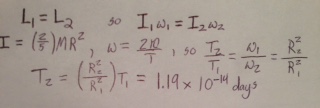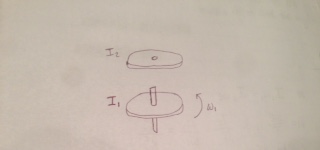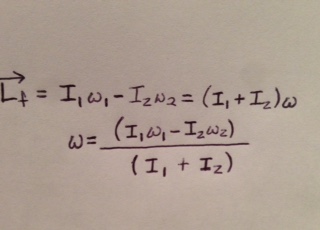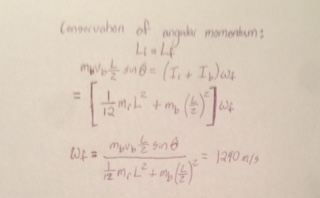Systems with Zero Torque: Difference between revisions
Dbaker63*2 (talk | contribs) No edit summary |
Dbaker63*2 (talk | contribs) No edit summary |
||
| Line 27: | Line 27: | ||
1. Suppose that a star initially had a radius about that of our Sun, 7x10^8km, and that it rotated every 26 days. What would be the period of rotation if the star collapsed to a radius of 10km? | 1. Suppose that a star initially had a radius about that of our Sun, 7x10^8km, and that it rotated every 26 days. What would be the period of rotation if the star collapsed to a radius of 10km?[Browne, Michael E. "Angular Momentum." Physics for Engineering and Science. Third ed. McGraw Hill Education, 2013. 134. Print.] | ||
Solution: | Solution: | ||
Revision as of 00:00, 6 December 2015
A Mathematical Model
It follows from the angular momentum principle, LAf = LAi + rnet*deltat that for systems with zero torque, LAf = LAi.
Computation Model
see corresponding section in http://www.physicsbook.gatech.edu/Torque
Examples
1. Suppose that a star initially had a radius about that of our Sun, 7x10^8km, and that it rotated every 26 days. What would be the period of rotation if the star collapsed to a radius of 10km?[Browne, Michael E. "Angular Momentum." Physics for Engineering and Science. Third ed. McGraw Hill Education, 2013. 134. Print.]
Solution:
2.An arrangement encountered in disk brakes and certain types of clutches is shown here. The lower disk. The lower disk, of moment of Inertia I1, is rotating with angular velocity 1. The upper disk, with moment of inertia I2, is lowered on to the bottom disk. Friction causes the two disks to adhere, and they finally rotate with the same angular velocity. Determine the final angular velocity if the initial angular velocity of the upper disk 2 was in the opposite direction as 1.
Solution:
3. A uniform thin rod of length 0.5 m and mass 4.0 kg can rotate in a horizontal plane about a vertical axis through its center. The rod is at rest when a 3.0 g bullet traveling the horizontal plane is fired into one end of the rod. As viewed from
above, the direction of the bullet’s velocity makes an angle of 60o with the rod. If the bullet lodges in the rod and the angular velocity of the rod is 10 rad/s immediately after the collision, what is the magnitude of the bullet’s velocity just before
the impact? [1]
Solution:
Connectedness
This principle directly relates to the bio-mechanical techniques used by various types of athletes, it can thus for example be incorporated into a physical analysis of extreme sports. Athletes (figure skaters, skateboarders, etc.) are able to employ this principle to increase the rates of rotation of there bodies without having to generate any net force. Given that Ltot = Ltrans + Lrot, and assuming that a change in Ltrans is trivial, it follows that Lrotf = Lroti. More specifically ωfIf = ωiIi. This relation implies that the athlete in question should be able to either increase or reduce their angular velocity by decreasing or increasing his or her moment of inertia respectively. Generally, this is accomplished by voluntarily cutting the distance between bodily appendages and the athlete's center of mass. In the example of a figure skater for instance, the moment of inertia is decreased by bringing in the arms and legs closer to the center of the body. Additionally, the athlete might crouch down in order to further decrease the total distance from his or her body’s center of mass. As a result, an inversely proportional change in the angular velocity of the athlete’s motion will occur, causing the speed of the athletes rotation either increase or decrease. <rev>Chabay, Ruth W., and Bruce A. Sherwood. "Angular Momentum." Matter & Interactions. 4rth ed. Vol. 1 : Modern Mechanics. Hoboken, NJ: Wiley, 2012. 434,440. Print.</ref>
[2]
As an LMC major, I am among the very few students at Georgia Tech for whom the zero-torque system method is not immediately applicable. If instead I was any sort of engineering major whatsoever, this would surely not be the case.
An immediate industrial example of a zero-torque system is alluded to in example problem two above. The zero-torque system is a very important method of abstraction in the field of control systems engineering. In particular, this perspective is instrumental for calculating selection factors for clutching and braking systems. Though often offered as separate components, their function are often combined into a single unit. When starting or stopping, they transfer energy between an output shaft and an input shaft through the point of contact. By considering the input shaft, output shaft and engagement mechanism as a closed system, researchers are enabled to make calculations that can inform them on how to engineer systems of progressively greater efficiency in regard to the mechanical advantage unique to different type of engagement system.<rev>http://www.controleng.com/single-article/selection-factors-for-clutches-amp-brakes/9fbd9f3d184754e5ced13817eff2c659.html. Retrieved December 3, 2015.</ref>  [3]
[3]
History
The empirical analysis of what might now be described as “zero-torque systems” by various natural philosophers pointed towards the principles of angular momentum and torque long before they were formulated in Newton’s Principia. The principle of torque was indicated as early as Archimedes (c. 287 BC - c.212 BC) who postulated the law of the lever. As written below, it essentially describes an event in which zero net torque on a system results in zero angular momentum(4).<rev>http://www.britannica.com/biography/Archimedes. Retrieved December 3. 2015.</ref> Much later on in 1609, the astronomer Johannes Kepler announced his discovery that planets followed an elliptical pattern around the Sun. More specifically, he claimed to have found that “a radius vector joining any planet to the sun sweeps out equal areas in equal lengths of time.” Mathematically, this area, (½)(rvsin) is proportional to angular momentum rmvsin. It was Newton’s endeavor to find an analytical solution for Kepler’s observations that lead to the derivation of his second law, The Momentum Principle, in the late 1600s.<rev>Chabay, Ruth W., and Bruce A. Sherwood. "Angular Momentum." Matter & Interactions. 4rth ed. Vol. 1 : Modern Mechanics. Hoboken, NJ: Wiley, 2012. 434,440. Print.</ref>
See also
http://www.physicsbook.gatech.edu/The_Moments_of_Inertia http://www.physicsbook.gatech.edu/Systems_with_Nonzero_Torque http://www.physicsbook.gatech.edu/The_Angular_Momentum_Principle http://www.physicsbook.gatech.edu/Torque http://www.physicsbook.gatech.edu/Predicting_the_Position_of_a_Rotating_System
Further Reading
Matter and Interactions, 4th edition, Volume 1.
External links
https://www.youtube.com/watch?v=whVCEIfTT0M
https://www.youtube.com/watch?v=jeB4aAVQMug
References
1. Browne, Michael E. "Angular Momentum." Physics for Engineering and Science. Third ed. McGraw Hill Education, 2013. 134. Print.
2.Chabay, Ruth W., and Bruce A. Sherwood. "Angular Momentum." Matter & Interactions. 4rth ed. Vol. 1 : Modern Mechanics. Hoboken, NJ: Wiley, 2012. 434,440. Print.
3.http://www.controleng.com/single-article/selection-factors-for-clutches-amp-brakes/9fbd9f3d184754e5ced13817eff2c659.html. Retrieved December 3, 2015.
4. http://www.britannica.com/biography/Archimedes. Retrieved December 3. 2015.
5. https://www.physics.ohio-state.edu/~gan/teaching/spring99/C12.pdf.Retrieved December 3, 2015.
6. https://upload.wikimedia.org/wikipedia/commons/f/fa/Car_clutch.png. Retrieved December 3, 2015.
7.http://qctimes.com/news/local/young-ice-skaters-shine-at-u-s-figure-skating-event/image_37e22f34-2c3a-5445-84cb-54972b525ad8.html. Retrieved December 3.2015.
- ↑ https://www.physics.ohio-state.edu/~gan/teaching/spring99/C12.pdf.Retrieved December 3, 2015.
- ↑ http://qctimes.com/news/local/young-ice-skaters-shine-at-u-s-figure-skating-event/image_37e22f34-2c3a-5445-84cb-54972b525ad8.html. Retrieved December 3.2015.
- ↑ https://upload.wikimedia.org/wikipedia/commons/f/fa/Car_clutch.png. Retrieved December 3, 2015.




